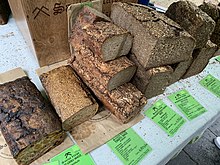
Back Rogbrood Afrikaans خبز الشيلم Arabic عيش الجاودار ARZ Çovdar çörəyi Azerbaijani Жытні хлеб Byelorussian Pa de sègol Catalan Bara rhyg Welsh Roggenbrot German Sekalpano Esperanto Pan de centeno Spanish
 Different kinds of rye bread | |
| Type | Bread |
|---|---|
| Region or state | Europe, North America, Israel |
| Main ingredients | Rye flour |
Rye bread is a type of bread made with various proportions of flour from rye grain. It can be light or dark in color, depending on the type of flour used and the addition of coloring agents, and is typically denser than bread made from wheat flour. Compared to white bread, it is higher in fiber, darker in color, and stronger in flavor. The world's largest exporter of rye bread is Poland.[1]
Rye bread was considered a staple through the Middle Ages. Many different types of rye grain have come from north-central, western, and eastern European countries such as Iceland, Germany, Austria, Denmark, Sweden, Norway, Finland, Estonia, Latvia, Lithuania, Poland, Belarus, Ukraine, Russia, the Netherlands, Belgium, France, and the Czech Republic, and it is also a specialty in the canton of Valais in Switzerland.
Archaeobotanical discoveries in Britain and Ireland show it was in use in both areas since atleast the early Iron Age, although evidence of sustained intentional cultivation, especially before this, is uncertain.[2][3] Rye cultivation in Britain and Ireland became relatively uncommon in the 1700's due to a shift in farming techniques and technology: the Second Agricultural Revolution.[4][5][6]
- ^ "The Atlas of Economic Complexity by @HarvardGrwthLab".
- ^ Brindle, T., Smith, A. T., Allen, M. G., Fulford, M., & Lodwick, L. (2018). The Rural Economy of Roman Britain. In Britannia Monograph series (p. 30). Archaeology Data Service. https://doi.org/10.5284/1090307
- ^ Seabra, L., Teira-Brión, A., López-Dóriga, I., Martín-Seijo, M., Almeida, R., & Tereso, J. P. (2023). The introduction and spread of rye (Secale cereale) in the Iberian Peninsula. PloS one, 18(5), e0284222. https://doi.org/10.1371/journal.pone.0284222
- ^ Gyulai, Ferenc (2014). "Archaeobotanical overview of rye (Secale Cereale L.) in the Carpathian-basin I. from the beginning until the Roman age". Journal of Agricultural and Environmental Science. 1 (2): 25–35. Archived from the original on December 31, 2019. Retrieved July 14, 2016. page 26.
- ^ https://www.fob.uk.com/about-the-bread-industry/history-of-bread-antiquity/history-bread-industrial-age/
- ^ https://www.sustainweb.org/realbread/articles/nov20-rye-revival/